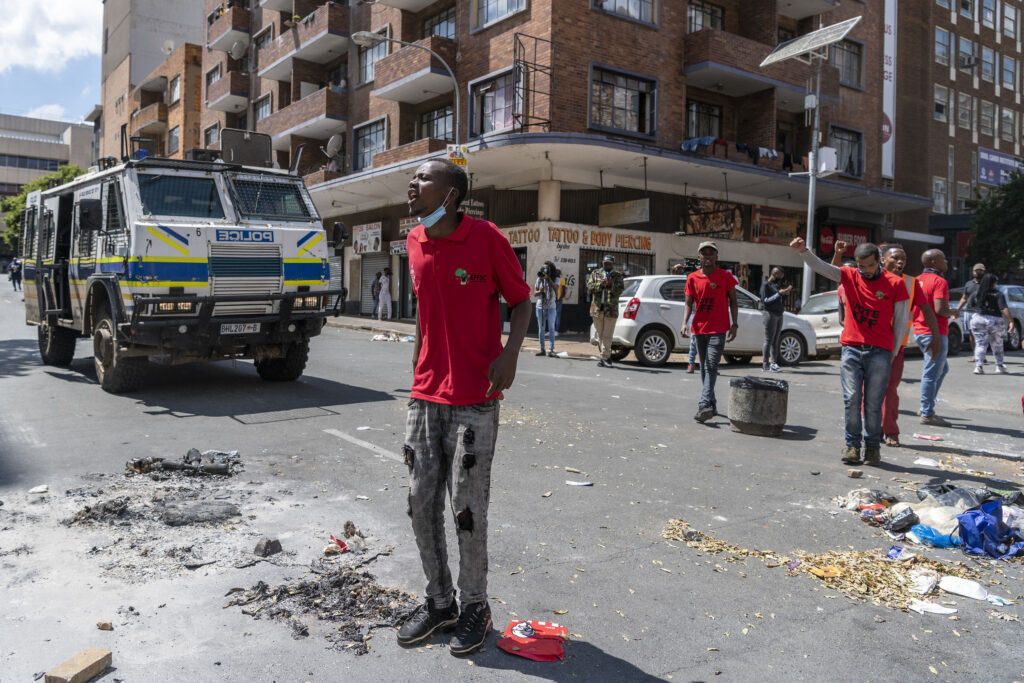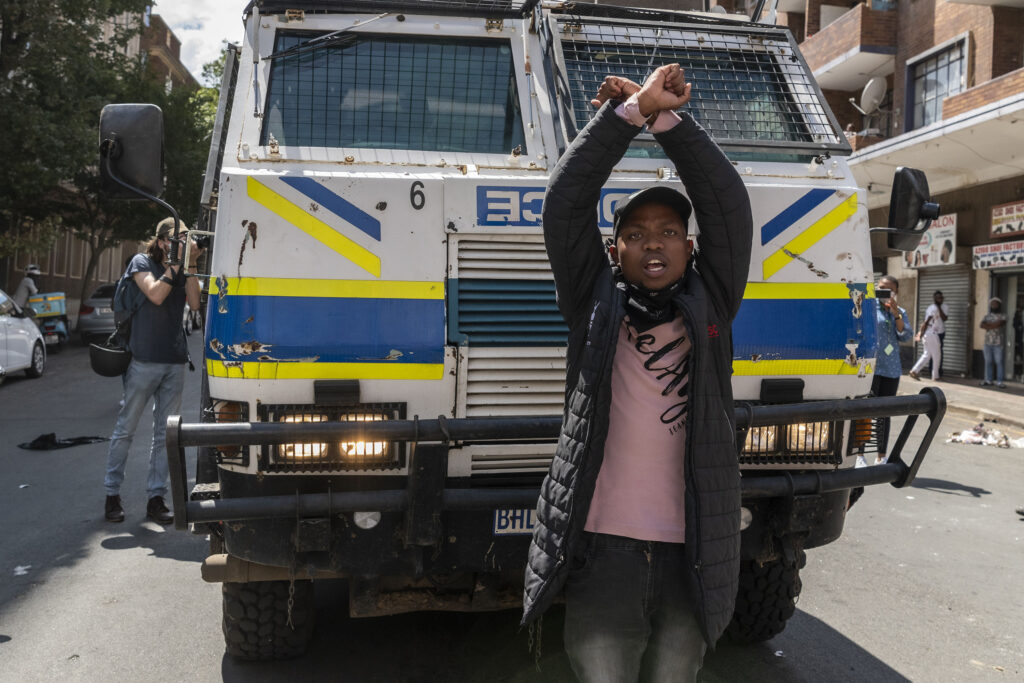Students continue to protest over university fees on March 15, 2021 in Johannesburg, South Africa. Students took to the streets of Johannesburg early on Monday to continue their protests about fees as 26 universities across SA braced for a national shutdown. Students, countrywide, demonstrated demanding that those who are in debt be allowed to register and that historical debt be wiped out. (Photo by Ihsaan Haffejee/Anadolu Agency via Getty Images)
High-school learners walking back from school look on with curiosity at students marching up Enoch Sontonga Avenue in Braamfontein, Johannesburg. Others stop to take videos.
Tailing the students are a police nyala and water cannon.
“At least abekho violent,” says one of the learners as they walk past.
In a few years, if they get into university and there is still no free higher education, these learners might find themselves part of a #FeesMustFall protest.
Some of the students who marched on Monday were still in high school, or even primary school, when a generation of students began protesting for free higher education, scrapping historical debt and free registration, as far back as 2007.
“These police are so scary. Don’t shoot at us,” one of the learners walking past the protests and police nyala shouts.
“ Yooh! Ngaze ngathuka [it’s so frightening],” he adds
The genesis of the calls for a nationwide shutdown
On Monday morning, several university campuses responded to a call by the South African Union of Students, the South African Students Congress (Sasco) and the Economic Freedom Fighters (EFF) Student Command for a national shutdown of higher education institutions, as students demand free higher education and that institutions register all students, including those with historical debt.
Students from technical and vocational education and training (TVET) colleges also joined the protest.
SAUS had given Higher Education Minister Blade Nzimande until Friday last week to respond to its 15 demands, mainly regarding funding, failing which they would go ahead with the shutdown.
Part of Nzimande’s response to SAUS was that his department was not in a financial position to support institutions to clear all fee-paying students’ debt.
A day in a student protest
On the way to their destination, the University of Witwatersrand students stop to collect tyres.
A Johannesburg Metro Police Department (JMPD) officer notices the students with the tyres. He gets out of the JMPD van and nearly sprints to confiscate the tyres from the students.
The students resist.
The nyala driver shouts to one of the students: “Ye ndoda, awulethe lama tyre. Asikusabi. [Young man, hand over those tyres. We are not afraid of you.]”
The students obliged. The JMPD officer throws the tyres into the nyala.
The group of students then turn onto Annet Road in Braamfontein. Traffic is slow. But cars are moving.
This was not the case earlier, when students had blocked the road with rubble and rocks on Jorissen Street. Cars were at a standstill.
One motorist insisted on driving through, but a student sat on top of his car’s bonnet. A JMPD officer later removed her.
The group finally arrives at its destination at the corner of Annet and Owl streets. Here they meet a larger group from the University of Johannesburg (UJ). There is jubilation. The students sing: “Asinavalo ngalento esiyenzayo [we have no fear].”
Amid the singing, they light tyres, block traffic, and there is an exchange of words between students and police officers. Police are visibly angry at the blocked traffic and the fiery tyres.
“You want to shoot us now?” some students yell at the officers.
One officer jumps into the water cannon’s driver’s seat, rolls up the window, and starts spraying water on the students and the tyres.
“Comrades, let’s move,” signals one of the students, who’s wearing an EFF Student Command T-shirt.
The group now marches back towards UJ’s Bunting Road campus.
As the protesting students march up Annet Road, students from UJ’s tourism and hospitality school come out to watch them.
“Sellouts,” protesting students yell.
The group reaches the Bunting Road campus and tries to push through the gate to get inside. The gate holds firm.
 Students block Johannesburg roads in protest over university fees. Students took to the streets of Johannesburg early on Monday to continue their protests about fees as 26 universities across SA braced for a national shutdown. Students, countrywide, demonstrated demanding that those who are in debt be allowed to register and that historical debt be wiped out. (Photo by Ihsaan Haffejee/Anadolu Agency via Getty Images)
Students block Johannesburg roads in protest over university fees. Students took to the streets of Johannesburg early on Monday to continue their protests about fees as 26 universities across SA braced for a national shutdown. Students, countrywide, demonstrated demanding that those who are in debt be allowed to register and that historical debt be wiped out. (Photo by Ihsaan Haffejee/Anadolu Agency via Getty Images)
Don’t forget Gloria in the stampede
Once inside campus, the group passes the Gloria Sekwena gate.
Gloria Sekwene was killed at that entrance in 2012 in a stampede that also injured 22 people.
She had gone to UJ to register her son when prospective students and their parents forced the gate open in a rush to try to secure a space at the institution. In 2014, UJ named the entrance after Sekwene.
After that incident, universities banned walk-ins.
‘Education is not even compulsory, but we are willing to die for it’
After spirited singing, a student leader addresses the crowd.
He tells them that the priority is free education and free registration for all. He delivers the message to loud cheers.
He also adds that, as the students leave the campus to march to the street of Braamfontein, they need to be united.
“The revolution has fallen because of individuals. We cannot allow that,” he says. The crowd heaves in agreement.
“High morale. High discipline,” another voice shouts.
The students have been protesting since morning. The Johannesburg sun is blisteringly hot, and some students stop to fill empty cold-drink containers with water. Others buy water from a woman who has been moving with the crowd and selling it.
Once outside of the Bunting Road campus, students sit in groups. They throw bricks and rubble on the road. They burn tyres.
With no nyalas or water cannons in sight, the air is now filled by a low-flying helicopter’s noise.
Students look up.
They begin filming the helicopter and continue blocking the road.
There are also discussions about where to go next. One group wants to move to the Johannesburg city centre, whereas the other wants to continue protesting in the streets of Braamfontein.
The back and forth continues for some time, while the helicopter continues to keep a beady eye on the protesters.
A student wearing an ANC T-shirt begins laughing.
“We are brave. For me, it is how we are willing to risk dying for school fees. School is not even compulsory,” she continues to laugh.
A consensus has been reached. The students will march to the Johannesburg city centre.
They make their way. On Smit Street, students stop at a scrap yard, where a group of men give them old tyres.
The helicopter is still hovering.
The march has been peaceful since students left UJ. They occasionally stop to put rubble on the road.
Then, suddenly, police emerge. The nyala and water cannon are back. They jump out of a combi carrying AK-47s.
Students scatter as the police remove the rubble from the road. The water cannon begins spraying students, and they drop the tyres that they were given and run.
A safe haven in a cemetery
Several police cars, many more than before, are circling, and students have run in all directions next to Braamfontein cemetery, not far from the M1 highway.
Later one student says: “I never thought the cemetery would be the safest place to hide.”
Those who could not run fast enough were told to get gone.
“Move. Go!” shouts an officer.
But one of the students is unable to move.
Dressed in a black-and-white striped short dress and sandals, the student looks fragile as her knee bleeds into the asphalt. Fellow students come to her aid, using an ANC-branded doek to wipe the blood from her knee.
 Students block Johannesburg roads in protest over university fees. Students took to the streets of Johannesburg early on Monday to continue their protests about fees as 26 universities across SA braced for a national shutdown. Students, countrywide, demonstrated demanding that those who are in debt be allowed to register and that historical debt be wiped out. (Photo by Ihsaan Haffejee/Anadolu Agency via Getty Images)
Students block Johannesburg roads in protest over university fees. Students took to the streets of Johannesburg early on Monday to continue their protests about fees as 26 universities across SA braced for a national shutdown. Students, countrywide, demonstrated demanding that those who are in debt be allowed to register and that historical debt be wiped out. (Photo by Ihsaan Haffejee/Anadolu Agency via Getty Images)
A week of protests and still no way forward
Last week, protesting Wits students marched to the ANC headquarters to deliver a memorandum demanding free education. At the height of Fees Must Fall in 2015, protesting university students also marched to Luthuli House to deliver a memorandum to the governing party.
At its 2007 elective conference in Polokwane, the ANC promised free higher education.
ANC-aligned student body, Sasco, has threatened that it will not campaign for the ANC in the upcoming local government elections until the money that has been defunded from the higher education sector has been given back.
According to Finance Minister Tito Mboweni’s February budget, a reduction of R24.6-billion was planned for the higher education department over the medium-term expenditure framework. This includes a reduction of R6.8-billion in the allocation to the National Student Financial Aid Scheme and R5-billion less for university subsidies.
On Monday, Sasco released a short statement announcing that its top five leadership had met with the ANC top six, including Mboweni and other ministers.
“At this point, we wish to say that the meetings have been positive, and there is hope that before the end of this week, we shall find lasting solutions on how the country should deal with historical debts, student funding, registration and justice for Mthokozisi Ntumba.”
Ntumba was shot and killed last week while coming out of a clinic on De Beer Street in Braamfontein, where students had been protesting.
Police watchdog the Independent Police Investigative Directorate announced on Monday that four police officers had been arrested in connection with the death of Ntumba.
They are facing four charges of murder, three charges of attempted murder, and defeating the ends of justice. The officers are expected to appear in the Johannesburg magistrate’s court on Wednesday.
At Graf Street, the injured student is carried into an ambulance by other students. She is treated in the ambulance, and later the ambulance drives away with her.
The helicopter has not stopped hovering.
Students then moved to Braamfontein, where police dispersed them with rubber bullets, teargas and others were arrested.
This is what categorised the first day of the national shutdown at two of Gauteng’s universities.